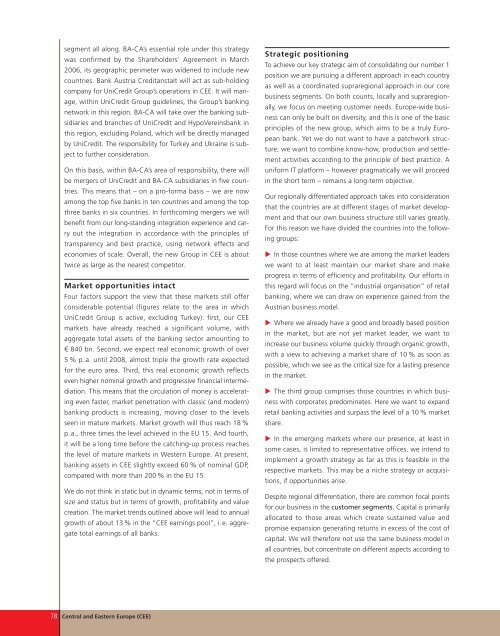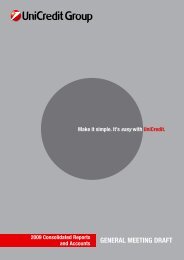team spirit - Bankier.pl
team spirit - Bankier.pl
team spirit - Bankier.pl
Create successful ePaper yourself
Turn your PDF publications into a flip-book with our unique Google optimized e-Paper software.
segment all along. BA-CA’s essential role under this strategy<br />
was confirmed by the Shareholders’ Agreement in March<br />
2006, its geographic perimeter was widened to include new<br />
countries. Bank Austria Creditanstalt will act as sub-holding<br />
company for UniCredit Group’s operations in CEE. It will manage,<br />
within UniCredit Group guidelines, the Group’s banking<br />
network in this region. BA-CA will take over the banking subsidiaries<br />
and branches of UniCredit and HypoVereinsbank in<br />
this region, excluding Poland, which will be directly managed<br />
by UniCredit. The responsibility for Turkey and Ukraine is subject<br />
to further consideration.<br />
On this basis, within BA-CA’s area of responsibility, there will<br />
be mergers of UniCredit and BA-CA subsidiaries in five countries.<br />
This means that – on a pro-forma basis – we are now<br />
among the top five banks in ten countries and among the top<br />
three banks in six countries. In forthcoming mergers we will<br />
benefit from our long-standing integration experience and carry<br />
out the integration in accordance with the princi<strong>pl</strong>es of<br />
transparency and best practice, using network effects and<br />
economies of scale. Overall, the new Group in CEE is about<br />
twice as large as the nearest competitor.<br />
Market opportunities intact<br />
Four factors support the view that these markets still offer<br />
considerable potential (figures relate to the area in which<br />
UniCredit Group is active, excluding Turkey): first, our CEE<br />
markets have already reached a significant volume, with<br />
aggregate total assets of the banking sector amounting to<br />
€ 840 bn. Second, we expect real economic growth of over<br />
5 % p.a. until 2008, almost tri<strong>pl</strong>e the growth rate expected<br />
for the euro area. Third, this real economic growth reflects<br />
even higher nominal growth and progressive financial intermediation.<br />
This means that the circulation of money is accelerating<br />
even faster, market penetration with classic (and modern)<br />
banking products is increasing, moving closer to the levels<br />
seen in mature markets. Market growth will thus reach 18 %<br />
p.a., three times the level achieved in the EU 15. And fourth,<br />
it will be a long time before the catching-up process reaches<br />
the level of mature markets in Western Europe. At present,<br />
banking assets in CEE slightly exceed 60 % of nominal GDP,<br />
compared with more than 200 % in the EU 15.<br />
We do not think in static but in dynamic terms, not in terms of<br />
size and status but in terms of growth, profitability and value<br />
creation. The market trends outlined above will lead to annual<br />
growth of about 13 % in the “CEE earnings pool”, i.e. aggregate<br />
total earnings of all banks.<br />
78 Central and Eastern Europe (CEE)<br />
Strategic positioning<br />
To achieve our key strategic aim of consolidating our number 1<br />
position we are pursuing a different approach in each country<br />
as well as a coordinated supraregional approach in our core<br />
business segments. On both counts, locally and supraregionally,<br />
we focus on meeting customer needs. Europe-wide business<br />
can only be built on diversity, and this is one of the basic<br />
princi<strong>pl</strong>es of the new group, which aims to be a truly European<br />
bank. Yet we do not want to have a patchwork structure;<br />
we want to combine know-how, production and settlement<br />
activities according to the princi<strong>pl</strong>e of best practice. A<br />
uniform IT <strong>pl</strong>atform – however pragmatically we will proceed<br />
in the short term – remains a long-term objective.<br />
Our regionally differentiated approach takes into consideration<br />
that the countries are at different stages of market development<br />
and that our own business structure still varies greatly.<br />
For this reason we have divided the countries into the following<br />
groups:<br />
� In those countries where we are among the market leaders<br />
we want to at least maintain our market share and make<br />
progress in terms of efficiency and profitability. Our efforts in<br />
this regard will focus on the “industrial organisation” of retail<br />
banking, where we can draw on experience gained from the<br />
Austrian business model.<br />
� Where we already have a good and broadly based position<br />
in the market, but are not yet market leader, we want to<br />
increase our business volume quickly through organic growth,<br />
with a view to achieving a market share of 10 % as soon as<br />
possible, which we see as the critical size for a lasting presence<br />
in the market.<br />
� The third group comprises those countries in which business<br />
with corporates predominates. Here we want to expand<br />
retail banking activities and surpass the level of a 10 % market<br />
share.<br />
� In the emerging markets where our presence, at least in<br />
some cases, is limited to representative offices, we intend to<br />
im<strong>pl</strong>ement a growth strategy as far as this is feasible in the<br />
respective markets. This may be a niche strategy or acquisitions,<br />
if opportunities arise.<br />
Despite regional differentiation, there are common focal points<br />
for our business in the customer segments. Capital is primarily<br />
allocated to those areas which create sustained value and<br />
promise expansion generating returns in excess of the cost of<br />
capital. We will therefore not use the same business model in<br />
all countries, but concentrate on different aspects according to<br />
the prospects offered.
















